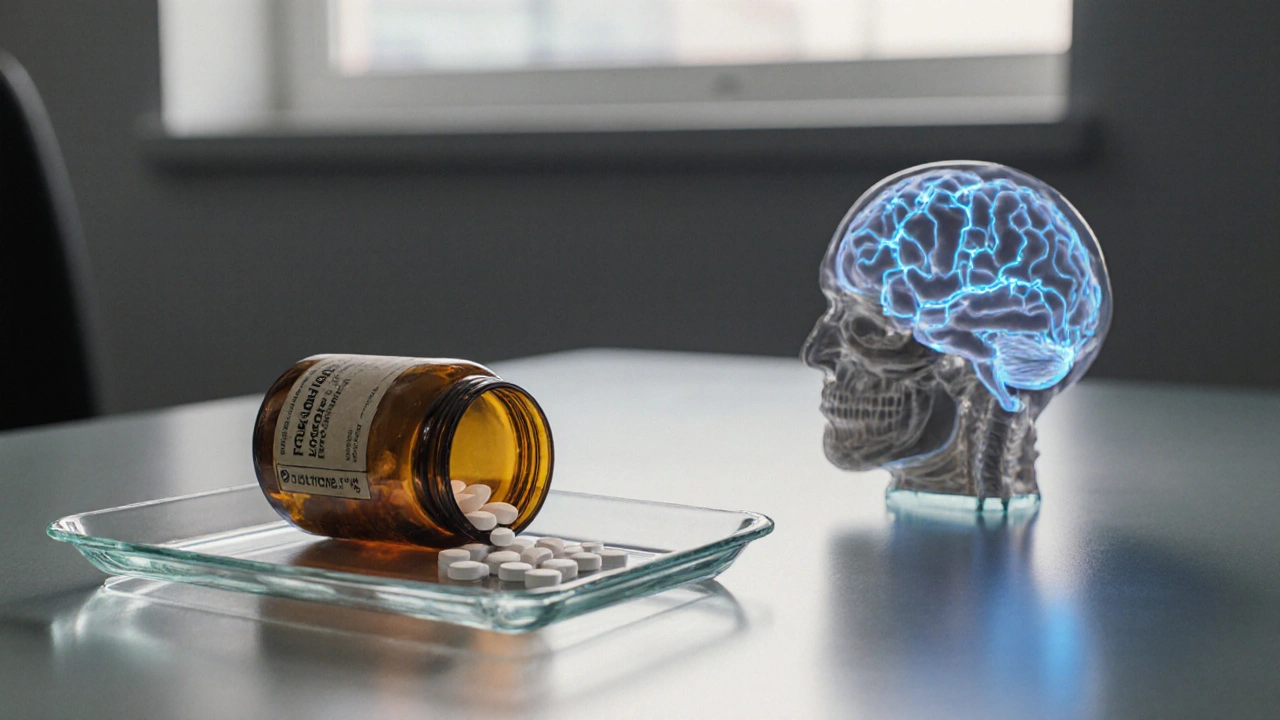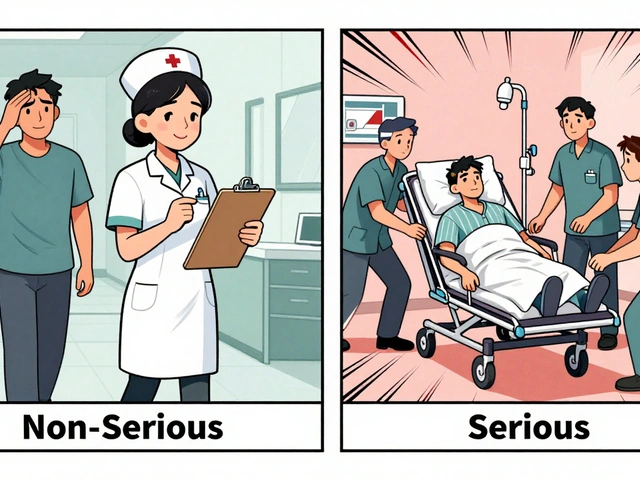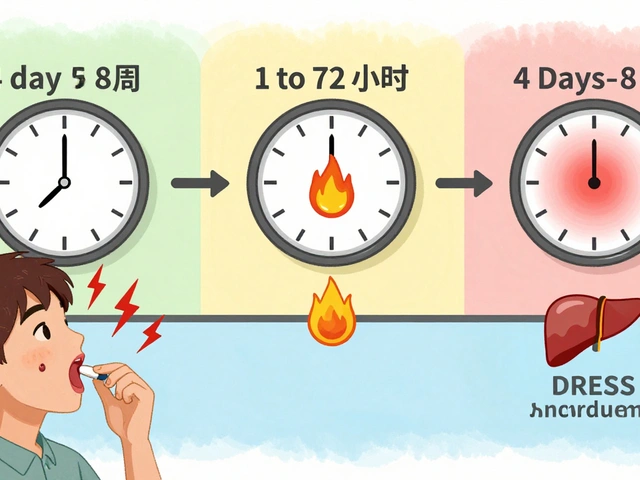
Antiepileptic Drug Comparison Tool
Select Your Situation
Answer these questions to find antiepileptic drugs that best match your needs.
Seizure Type
Age Group
Medication Interactions
Side Effect Tolerance
Cost Considerations
Key Takeaways
- Primidone (Mysoline) is an older barbiturate‑like drug mainly used for focal and generalized seizures.
- Newer alternatives such as levetiracetam, lamotrigine, and topiramate often offer better tolerability and fewer drug interactions.
- Choice hinges on seizure type, comorbid conditions, age, and potential side‑effects.
- Switching requires a gradual taper and close monitoring for seizure breakthrough.
- Consult a neurologist to tailor the regimen to your specific needs.
What Is Primidone (Mysoline)?
Primidone is a long‑standing antiepileptic medication that belongs to the barbiturate class. Marketed as Mysoline, it was first approved by the FDA in 1954 and has been a go‑to option for patients with myoclonic, tonic‑clonic, and focal seizures.
Primidone works by enhancing the activity of gamma‑aminobutyric acid (GABA), the brain’s chief inhibitory neurotransmitter. By increasing GABA‑mediated inhibition, neuronal firing calms down, reducing the likelihood of a seizure.
How Primidone Is Used
Typical adult dosing starts at 50mg once daily, titrating up to 500‑750mg per day in divided doses. Children often receive lower weight‑adjusted doses, beginning at 2‑3mg/kg/day.
Because the drug is metabolized into phenobarbital, patients may experience similar side‑effects, such as drowsiness, dizziness, or ataxia. Blood‑level monitoring isn’t routine but may be ordered for patients on high doses or with renal impairment.
Who Might Prefer Primidone?
Primidone shines in a few niche scenarios:
- Patients with essential tremor where other tremor‑specific meds have failed.
- Individuals who have responded well historically and cannot tolerate newer agents.
- Settings where cost is a major barrier; generic primidone is usually cheaper than many newer AEDs.
Alternatives to Primidone
Below are the most common alternatives, each with distinct mechanisms and safety profiles.
Levetiracetam is a broad‑spectrum AED that binds to the synaptic vesicle protein SV2A, modulating neurotransmitter release. It was approved in 1999 and is praised for minimal drug interactions.
Lamotrigine inhibits voltage‑gated sodium channels, stabilising neuronal membranes. Introduced in 1994, it’s especially effective for focal seizures and bipolar depression.
Topiramate blocks sodium channels and enhances GABA activity while also inhibiting AMPA/kainate receptors. Since its 1996 approval, it’s become a popular choice for refractory seizures.
Carbamazepine stabilises the inactivated state of voltage‑gated sodium channels. It’s a first‑line agent for focal seizures and trigeminal neuralgia, approved in 1968.
Valproic Acid increases GABA concentrations and blocks sodium channels. Its broad spectrum covers generalized seizures, though liver toxicity limits use in women of child‑bearing age.
Phenobarbital is another barbiturate that potentiates GABA receptors. It’s inexpensive but heavily sedating and has a high potential for dependence.
Side‑Effect Snapshots
All antiepileptic drugs carry risks. Here’s a quick look at the most frequent adverse events for each option.
- Primidone: drowsiness, dizziness, nystagmus, potential for long‑term sedation.
- Levetiracetam: irritability, mood swings, fatigue; rare Stevens‑Johnson syndrome.
- Lamotrigine: rash (including potentially life‑threatening), dizziness, diplopia.
- Topiramate: weight loss, cognitive slowing, kidney stones, paresthesia.
- Carbamazepine: hyponatraemia, rash, liver enzyme elevation, dizziness.
- Valproic Acid: weight gain, hair loss, hepatotoxicity, teratogenicity.
- Phenobarbital: profound sedation, respiratory depression, dependence.
Comparison Table
| Drug | Mechanism | Typical Daily Dose | Common Side‑Effects | Notable Drug Interactions | Best For |
|---|---|---|---|---|---|
| Primidone | Enhances GABA (via phenobarbital metabolite) | 50‑750mg | Drowsiness, dizziness, nystagmus | Induces CYP3A4, lowers levels of oral contraceptives | Essential tremor, patients needing low cost |
| Levetiracetam | SV2A binding, modulates neurotransmitter release | 500‑3000mg | Irritability, fatigue, rash | Minimal CYP involvement | Broad‑spectrum, patients on polypharmacy |
| Lamotrigine | Sodium‑channel blockade | 100‑400mg | Rash, dizziness, diplopia | Increases carbamazepine levels | Focal seizures, mood stabilization |
| Topiramate | Sodium‑channel block + GABA enhancement | 100‑400mg | Weight loss, cognitive dulling, kidney stones | Reduces effectiveness of oral contraceptives | Refractory seizures, migraine prophylaxis |
| Carbamazepine | Sodium‑channel inactivation | 200‑1200mg | Hyponatraemia, rash, dizziness | Strong CYP3A4 inducer, many interactions | Focal seizures, trigeminal neuralgia |
| Valproic Acid | Increases GABA, blocks sodium channels | 500‑2000mg | Weight gain, hair loss, liver toxicity | Inhibits CYP2C9, interacts with lamotrigine | Generalized seizures, absence epilepsy |

Decision Factors: When to Stay with Primidone vs. Switch
Think of the choice as a balance sheet. Write down what you gain and lose with each option.
- Seizure type: If you have focal seizures that responded to primidone, you may stay. For mixed generalized seizures, levetiracetam or valproic acid could be better.
- Age and comorbidities: Older adults often tolerate primidone’s sedation less well. Younger patients might benefit from the cognitive profile of lamotrigine.
- Drug‑interaction burden: Patients on many meds (e.g., antidepressants, antihypertensives) usually prefer levetiracetam because it hardly affects CYP enzymes.
- Side‑effect tolerance: If daytime drowsiness interferes with work, a switch to topiramate-despite its cognitive side‑effects-might be acceptable.
- Cost considerations: Generic primidone is cheap; newer AEDs can cost 5‑10× more, which matters if you lack insurance coverage.
Practical Tips for Switching From Primidone
Never quit cold turkey. A typical taper looks like this:
- Week1‑2: Reduce primidone by 25% of the total daily dose.
- Week3‑4: Add the new AED at a low starting dose (e.g., levetiracetam 250mg BID).
- Week5‑6: Further cut primidone by another 25% while slowly increasing the new drug to its target dose.
- Week7‑8: Discontinue primidone completely if seizure control remains stable.
Throughout, keep a seizure diary and schedule weekly blood work if the new drug requires monitoring (e.g., lamotrigine levels). Communicate any new symptoms-especially rash, mood changes, or excessive fatigue-to your neurologist immediately.
When to Seek Professional Guidance
Switching AEDs is a high‑stakes move. If you notice any of the following, call your doctor right away:
- Increase in seizure frequency or severity.
- New rash, especially on the torso or face.
- Sudden mood swings, depression, or anxiety.
- Signs of liver trouble-jaundice, dark urine, persistent nausea.
These warnings often signal that the new medication needs dose adjustment or that a different alternative might be safer.
Frequently Asked Questions
Can I use primidone and levetiracetam together?
Yes, they can be combined, but the total sedative load may increase. Doctors usually start levetiracetam at a low dose and monitor for excess drowsiness.
Why does primidone cause nystagmus?
Nystagmus stems from the drug’s barbiturate effect on the brainstem’s vestibular nuclei, which coordinate eye movements.
Is topiramate safe for people with kidney stones?
Topiramate can raise the risk of kidney stones because it promotes calcium phosphate crystallization. Patients with a history of stones should discuss alternatives with their neurologist.
How long does it take for primidone to reach steady‑state levels?
Steady‑state is typically reached after 5‑7days of consistent dosing, matching the drug’s half‑life of roughly 10‑12hours.
Can women who are pregnant take primidone?
Primidone is classified as FDA Pregnancy Category C; animal studies show risk, but human data are limited. Doctors often prefer alternatives like lamotrigine or levetiracetam during pregnancy.
12 Comments
Suman Wagle
October 16, 2025 at 13:20 PM
One could argue that the very act of comparing drugs is an exercise in futility, as if we could ever capture the messy reality of a brain in seizure. Yet the spreadsheet does force us to confront our own biases. The irony is delicious: we trust algorithms more than the seasoned neurologist’s gut. Still, the tool reminds us that every choice carries a hidden trade‑off. So, pick your poison with a smile.
Neil Sheppeck
October 20, 2025 at 12:43 PM
If you’re juggling cost, side‑effects, and seizure type, think of the decision like building a balanced playlist-each track (drug) brings its own vibe. Primidone may sit low on the budget chart, while levetiracetam tops the interaction‑free list. For older folks who can’t handle sedation, lamotrigine’s gentle cognitive profile could be the sweet spot. Remember, the best regimen is the one you can actually stick to. Keep a diary, listen to your body, and adjust the mix as life changes.
Stephanie S
October 24, 2025 at 12:06 PM
Primidone, a drug first approved in 1954, remains on the market primarily because of its low cost; however, its side‑effect profile-drowsiness, dizziness, nystagmus-can be quite limiting, especially for patients who need to stay alert; on the other hand, newer agents such as levetiracetam and lamotrigine offer a cleaner adverse‑event slate, with minimal drug interactions, making them attractive options for polypharmacy patients; still, when insurance coverage is sparse, the price advantage of generic primidone cannot be ignored; thus, clinicians must weigh efficacy, tolerability, and economics before prescribing.
Bradley Fenton
October 28, 2025 at 11:30 AM
If your wallet screams, primidone answers.
Wayne Corlis
November 1, 2025 at 10:53 AM
When you stare at the comparison chart, the first thing that hits you is the sheer optimism of the designers, as if a spreadsheet could replace the nuanced art of neurology.
Primidone, a relic from the barbiturate era, is presented alongside sleek, modern molecules like levetiracetam, and the juxtaposition feels like a costume party where the old man shows up in a tuxedo.
One must ask whether the cheap cost of primidone truly outweighs the cognitive fog that can turn a simple morning into a hazy existential crisis.
The table lists side‑effects with the kind of clinical detachment that would make a butcher blush; drowsiness, dizziness, and nystagmus are enumerated like ingredients in a questionable recipe.
Meanwhile, lamotrigine’s reputation for mood stabilization is noted, suggesting that seizure control and emotional health can be pursued in tandem, a notion that feels almost poetic.
Topiramate’s weight‑loss promise is highlighted, yet the cognitive dulling it brings is conveniently footnoted, as if a small price can be paid for a slimmer waist.
Levetiracetam’s minimal drug interactions are praised, but the subtle irritability it can cause is tucked away in a corner, an omission that would make a philosopher wince.
The cost column, with its stark numbers, reminds us that medicine is also a market, and that patients often have to choose between financial solvency and neurological stability.
Switching from primidone to a newer agent isn’t as simple as swapping a light bulb; the taper schedule alone reads like a military operation.
The recommended taper-reduce by 25 percent every two weeks while introducing the new drug-sounds reasonable, but real‑world adherence is a different beast.
Patients often forget to keep seizure diaries, and clinicians may miss subtle signs of rash or mood swings that herald serious adverse events.
In practice, the decision boils down to a personal calculus: how much drowsiness can you tolerate before your work suffers?
How much are you willing to pay for the peace of mind that comes with fewer drug interactions?
And, perhaps most importantly, how much trust do you place in a generic pill versus a brand‑name marvel?
Ultimately, the chart is a map, not the territory, and navigating it requires both data and the humility to accept that no single drug reigns supreme.
Kartikeya Prasad
November 5, 2025 at 10:16 AM
Wow, look at that cost column-it's practically screaming “budget-friendly” while the side‑effects quietly mime a silent film. Sure, primidone is cheap, but you get a front‑row seat to drowsiness and occasional nystagmus. If you love hanging on to your paycheck, congratulations, you’ve found a hero. 😏
HARI PRASATH PRASATH
November 9, 2025 at 09:40 AM
Honestly, the whole comparsion feels like a pretentious art project, draped in fancy tables while ignoring the gritty reality of patient experiences. Who needs another spreadsheet when real lives are at stake? The author should grab a stethoscope instead of a cursor.
Andrew Miller
November 13, 2025 at 09:03 AM
I sit in the corner of the comment thread, watching the debate about cheap pills versus shiny new drugs, feeling the weight of every seizure that went unnoticed. It’s haunting, the way cost can dictate health, and I can’t help but absorb the collective anxiety.
Brent Herr
November 17, 2025 at 08:26 AM
Stop sugar‑coating the reality, Neil. Your “playlist” analogy ignores that a cheap drug like primidone can actually jeopardize a patient’s livelihood with its sedation. You can’t just tell people to “stick to the mix” when the mix includes a sedative that knocks them out of work.
Jill Brock
November 21, 2025 at 07:50 AM
Richard, your drama‑queen lament about “cheap doesn’t mean wise” is as overblown as a soap‑opera plot twist. If you think cost is the villain, you’re missing the fact that for many, it’s the only hero they can afford.
Andrew Stevenson
November 22, 2025 at 13:56 PM
From a pharmacoeconomic perspective, the decision matrix outlined in the tool aligns with evidence‑based guidelines: cost‑effectiveness ratios, number needed to treat, and adverse event profiles should be integrated into shared decision‑making. Leveraging therapeutic drug monitoring where applicable can further optimise outcomes.






Richard Phelan
October 12, 2025 at 13:56 PM
Primidone's price tag is the only thing that makes it survive in the AED market today. Its barbiturate‑like side‑effects, however, are a drama queen's nightmare-drowsiness, nystagmus, the whole circus. If you can live with the sedation, you’ll get a cheap seizure shield, but don’t pretend it’s a miracle drug. The real moral question is whether you’d rather pay more for a cleaner side‑effect profile. In short, cheap doesn’t always mean wise.